Rankiem zaglądamy jeszcze do wnętrza kanionu de Chelly, a następnie dalej w drogę do Monument Valley.
Tsé Biiʼ Ndzisgaii – „dolina skał”, znana przede wszystkim jako Monument Valley Navajo Tribal Park to region płaskowyżu Colorado charakteryzujący się skupiskiem potężnych piaskowcowych skał, z których największe wznoszą się ponad 300 m ponad dnem doliny. Leży na granicy stanów Arizona i Utah, na terenie Rezerwatu Narodu Navajo. Reżyser John Ford wykorzystał lokalizację podczas kręcenia wielu swoich najbardziej znanych filmów, w ten sposób, jak opisał to Keith Phipps, „te pięć mil kwadratowych określiło, jak przez dziesięciolecia widzowie wyobrażali sobie amerykański Dziki Zachód”. Dno doliny jest w dużej mierze zbudowane z aulerytu z grupy Cutlerów i pochodzącego z niego piasek, rzeźbiony i osadzany przez meandrujące rzeki, które wyrzeźbiły dolinę. Żywy czerwony kolor doliny pochodzi z tlenku żelaza odsłoniętego z wietrzejącego aulerytu. Ciemniejsze, niebieskoszare skały w dolinie zawdzięczają barwę tlenkom manganu. Skalne wieże (buttes) są wyraźnie rozwarstwione, z trzema głównymi warstwami. Najniższą warstwą jest łupek Organ Rock Shale, środek to piaskowiec de Chelly, a górna warstwa to formacja Moenkopi ograniczona przez konglomerat Shinarump.[:en]
In the morning we take a drive with a Navajo guide into Canyon de Chelly and then move on to Monument Valley.
Tsé Biiʼ Ndzisgaii – “valley of the rocks”, known by most as Monument Valley Navajo Tribal Park is a region of the Colorado Plateau characterized by a cluster of vast sandstone buttes, the largest rising over 300 m above the valley floor, at the Arizona–Utah border. The valley lies within the territory of the Navajo Nation Reservation. Director John Ford used the location for a number of his best-known films and thus, in the words of critic Keith Phipps, “its five square miles have defined what decades of moviegoers think of when they imagine the American West.” The valley floor is largely siltstone of the Cutler Group, or sand derived from it, deposited by the meandering rivers that carved the valley. The valley’s vivid red color comes from iron oxide exposed in the weathered siltstone. The darker, blue-gray rocks in the valley get their color from manganese oxide. The buttes are clearly stratified, with three principal layers. The lowest layer is the Organ Rock Shale, the middle is de Chelly Sandstone, and the top layer is the Moenkopi Formation capped by Shinarump Conglomerate. [:]



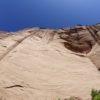
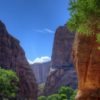
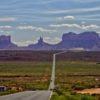

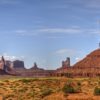

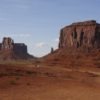

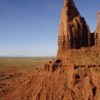
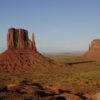
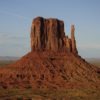
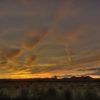
Leave a Reply